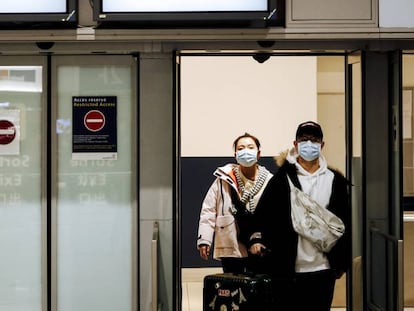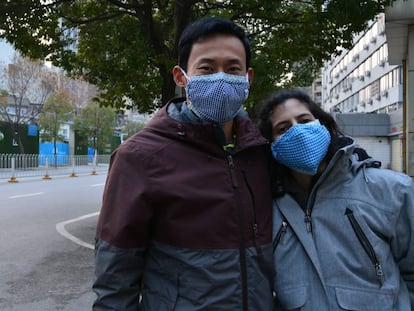Evacuated Spaniards will spend coronavirus quarantine at Madrid hospital
Consulate tells affected citizens they will fly out on Thursday or Friday on a plane chartered by Britain

Spaniards who are evacuated from Wuhan due to the outbreak of the novel coronavirus, technically known as 2019-nCoV, will spend their first 14 days back in Spain in isolation at a Madrid hospital.
The quarantined evacuees will have an entire floor to themselves, where they will be able to receive some visits and wear their own clothes. There will be a playroom, as authorities are expecting to repatriate several children from the epicenter of the outbreak. These are the measures planned by the Health Ministry for the 20 or so Spaniards who are expected to arrive in Madrid shortly.
The Spanish consulate in China has told affected citizens that they will fly out on Thursday on an aircraft chartered by Britain. The plane, which is owned by the Spanish airline Wamos, is currently in Hanoi (Vietnam) and is expected to land in Wuhan later today. The evacuees will fly out late on Thursday or in the early hours of Friday, according to the consulate, although local officials still have to authorize the operation. Earlier this week, authorities said they were in talks with France, which is chartering planes for its own citizens and said it was willing to assist other nationals as well.
Chinese health authorities will screen passengers and hold back anyone showing symptoms of the disease
Fernando Simón, director of the Health Ministry’s Coordination Center for Health Alerts and Emergencies, told this newspaper that all measures have been agreed to by other EU countries and by China, to ensure everyone adopts similar precautions. These measures, he said, “are above and beyond what is necessary considering what we know about the disease.”
Although Spain originally favored having people spend the quarantine period in their own homes, as Japan is doing, other EU members had diverging views on the matter, and the final agreement represents “a middle ground.”
China is only allowing foreigners out of Wuhan on condition that the necessary safety measures will be adopted, including a quarantine period. Simón said that before letting them out of the city, Chinese health authorities will screen passengers and hold back anyone showing symptoms of the disease. The French health minister, however, said that her country could provide aero-medical evacuation.

Spaniards trapped in the Chinese city said they were “energized” by the news of their upcoming evacuation. “It’s like a rush of energy, because it’s like seeing the light at the end of the tunnel,” said Óliver Cuadrado, who works for the local soccer team Wuhan Shangwen.
“We’ve been saying for days that we wouldn’t have a problem with undergoing health checks or being quarantined. It’s rather the other way around: we would love to, as we all have families and the last thing we want to do is to expose them to any risks,” added Cuadrado, expressing hope that a return date will be set soon. “All we want is for all this to pass as soon as possible so we can get on with our lives.”
Measures in Madrid
Once the Spaniards arrive at Madrid’s Adolfo Suárez-Barajas airport, a bus will take them to an undisclosed hospital and they will spend 14 days there under observation. Any visiting relatives will have to wear gloves and face masks, avoid physical contact and undergo health checks of their own.
The arrival of the evacuees from Wuhan will not “change the risk” that Spain faces, said Simón. Although the World Health Organization has raised its global risk assessment to “high,” this is because “it is applied to many countries, but there are vast differences among these.”
“In our own situation, our circumstances, our surroundings, the risk is moderate,” added Simón.
So far, the coronavirus has infected over 6,000 people and caused 169 deaths, overtaking the number of people affected by the SARS epidemic of 2002-2003. However, SARS was much more lethal, killing 10% of patients, while the Wuhan virus has a death rate of 2%, chiefly among individuals with existing respiratory problems.
With additional reporting by Jaime Santirso and Silvia Ayuso.
Passengers trapped on cruise ship

Around 6,000 passengers aboard a cruise ship are being held at the port of Civitavecchia (Italy) after a woman began to show symptoms suggesting she may be infected with the 2019-nCoV coronavirus. The vessel had made previous stops in Spain and there are several Spanish citizens on board. The passengers will not be allowed on land until the results of the test are in, Lorena Pacho reports.
Health protocols were activated after the woman, a native of Hong Kong, developed a fever and respiratory problems during the voyage. Her husband is asymptomatic, but remains in isolation in the vessel’s hospital area. A medical team from Spallanzani Hospital in Rome specializing in infectious diseases boarded the vessel on Thursday morning to take samples for analysis.
According to Italian media, the couple arrived at Milan airport on January 25 and traveled to the port of Savona in Genoa to begin their sea voyage. Before stopping in Genoa, the cruise ship had made stops in Marseille, Barcelona and Palma de Mallorca.
English version by Susana Urra.
Tu suscripción se está usando en otro dispositivo
¿Quieres añadir otro usuario a tu suscripción?
Si continúas leyendo en este dispositivo, no se podrá leer en el otro.
FlechaTu suscripción se está usando en otro dispositivo y solo puedes acceder a EL PAÍS desde un dispositivo a la vez.
Si quieres compartir tu cuenta, cambia tu suscripción a la modalidad Premium, así podrás añadir otro usuario. Cada uno accederá con su propia cuenta de email, lo que os permitirá personalizar vuestra experiencia en EL PAÍS.
¿Tienes una suscripción de empresa? Accede aquí para contratar más cuentas.
En el caso de no saber quién está usando tu cuenta, te recomendamos cambiar tu contraseña aquí.
Si decides continuar compartiendo tu cuenta, este mensaje se mostrará en tu dispositivo y en el de la otra persona que está usando tu cuenta de forma indefinida, afectando a tu experiencia de lectura. Puedes consultar aquí los términos y condiciones de la suscripción digital.
More information

Spain trying to evacuate its citizens from Wuhan along with French, British nationals
Últimas noticias
Maduro pleads not guilty before the federal court in New York: ‘I am still the president of Venezuela’
A new test can detect Alzheimer’s from a finger prick
UN team enters Sudanese city of El Fasher after paramilitary massacre: ‘It’s like a ghost town’
A recipe for resistance: Indigenous peoples politicize their struggles from the kitchen
Most viewed
- Gilles Lipovetsky: ‘If you want to live better and fall in love, take Prozac, don’t look to philosophy’
- Alain Aspect, Nobel laureate in physics: ‘Einstein was so smart that he would have had to recognize quantum entanglement’
- Alvin Hellerstein, a 92-year-old judge appointed by Bill Clinton, to preside over Maduro’s trial in New York
- Why oil has been at the center of Venezuela-US conflicts for decades
- Maduro’s downfall puts China’s relationship with Venezuela to the test










































